Using Cartographic Documents to Provide Geoinformation on the Rights to Real Estate—Taking Poland as an Example
Abstract
1. Introduction
2. Materials and Methods
3. Results and Discussion
3.1. Rights to Place Devices on the Property
3.2. Utility Networks and Related Rights on Cartographic Studies
- where the utility networks are located;
- what utility networks are on the property;
- what rights are vested in the utility company to a given area of real estate.
3.3. SWOT Analysis
4. Conclusions
Author Contributions
Funding
Conflicts of Interest
References and Notes
- SDG Zero Hunger. Available online: https://www.un.org/sustainabledevelopment/hunger/ (accessed on 27 September 2019).
- Alattas, A.; Van Oosterom, P.; Zlatanova, S. Deriving the Technical Model for the Indoor Navigation Prototype Based on the Integration of IndoorGML and LADM Conceptual Model. In Proceedings of the 7th International FIG Workshop on the Land Administration Domain Model, 20–21 October 2018; FIG (International Federation of Surveyors): Copenhagen, Denmark, 2018; pp. 246–266. [Google Scholar]
- Alattas, A.; Zlatanova, S.; Van Oosterom, P.; Chatzinikolaou, E.; Lemmen, C.; Li, K.-J. Supporting Indoor Navigation Using Access Rights to Spaces Based on Combined Use of IndoorGML and LADM Models. ISPRS Int. J. Geo-Inf. 2017, 6, 384. [Google Scholar] [CrossRef]
- Alattas, A.; van Oosterom, P.; Zlatanova, S.; Diakité, A.; Yan, J. Developing a Database for the LADM-IndoorGML Model. In Proceedings of the 6th International FIG 3D Cadastre Workshop, Delft, The Netherlands, 2–4 October 2018. [Google Scholar]
- Elia, E.A.; Zevenbergen, J.A.; Lemmen, C.; van Oosterom, P.J.M. The land administration domain model (LADM) as the reference model for the Cyprus land information system (CLIS). Surv. Rev. 2013, 45, 100–110. [Google Scholar] [CrossRef]
- Commission Regulation (EU) No 1253/2013 of 21 October 2013 amending Regulation (EU) No 1089/2010 Implementing Directive 2007/2/EC as Regards Interoperability of Spatial Data Sets 82 V. Cetl et al. and Services (2013). Available online: http://eur-lex.europa.eu/LexUriServ/LexUriServ.do?uri=OJ%3AL%3A2013%3A331%3A0001%3A0267%3AEN%3APDF (accessed on 19 November 2019).
- Directive 2007/2/EC of the European Parliament and of the council of 14 March 2007 Establishing an Infrastructure for Spatial Information in the European Community (INSPIRE). Available online: http://eur-lex.europa.eu/legal-content/EN/ALL/?uri=CELEX:32007L0002 (accessed on 19 November 2019).
- INSPIRE Metadata Implementing Rules: Technical guidelines based on EN ISO 19115 and EN ISO 19119. Available online: http://inspire.ec.europa.eu/documents/Metadata/MD_IR_and_ISO_20131029.pdf (accessed on 19 November 2019).
- Döllner, J.; Jobst, M.; Schmitz, P. (Eds.) Service-Oriented Mapping, Lecture Notes in Geoinformation and Cartography; Springer: Berlin/Heidelberg, Germany, 2018. [Google Scholar] [CrossRef]
- Civil Code of 23 April 1964 (Kodeks Cywilny). Article 46. J. Laws 2019. item 1145. Available online: www.isap.sejm.gov.pl (accessed on 19 November 2019). (In Polish).
- Act on Real Estate Management of 1 August 1997 (ustawa o gospodarce nieruchomosciami). J. Laws 2018. item 2204. Available online: www.isap.sejm.gov.pl (accessed on 19 November 2019). (In Polish).
- Rudnicki, S. O Pojęciu Nieruchomości w Prawie Cywilnym (On the Concept of Real Estate in Civil Law). In Przegląd Sądowy; Wolters Kluwer: Philadelphia, PA, USA, 1999; Number 9; p. 69. [Google Scholar]
- Judgement of Supreme Court of 26 February 2003. II CKN 1306/00, LEX no 83961.
- Act on Land and Mortgage Registers of 6 July 1982 (o księgach wieczystych i hipotece) Article 21. Laws 2018. item 1916. Available online: www.isap.sejm.gov.pl (accessed on 19 November 2019). (In Polish).
- Civil Code of 23 April 1964 (Kodeks Cywilny). Article 143. J. Laws 2019. item 1145. Available online: www.isap.sejm.gov.pl (accessed on 19 November 2019). (In Polish).
- Available online: geoportal.gov.pl (accessed on 27 September 2019).
- Bojarski, W. Prawo Rzymskie (Roman law); Wydawnictwo Dom Organizatora: Toruń, Poland, 1999. [Google Scholar]
- Wasilkowski, J. Prawo Własności w PRL (Property Right in the People’s Republic of Poland); Państwowe Wydawnictwo Naukowe: Warsaw, Poland, 1969; p. 133. [Google Scholar]
- Geodetic and Cartographic Law of 17 May 1989 (Prawo Geodezyjne i Karograficzne). Article 20. J. Laws 2019. item 725. Available online: www.isap.sejm.gov.pl (accessed on 19 November 2019). (In Polish).
- Geodetic and Cartographic Law of 17 May 1989 (Prawo Geodezyjne i Karograficzne). Article 24. J. Laws 2019. item 725. Available online: www.isap.sejm.gov.pl (accessed on 19 November 2019). (In Polish).
- Dawidowicz, A.; Źróbek, R. Ewolucja Potencjału Systeu Katastralnego Nieruchomości w Polsce w Świtle Zaiżęń Międzynarodowej Federacji Geodetów (FIG) (The Evolution of the Potential of the Cadastral System of Real Estate in Poland in the Light of the Assumptions of the International Federation of Surveyors); Studia i Materiały Towarzystwa Naukowego Nieruchomości: Olsztyn, Poland, 2011; Volume 19. [Google Scholar]
- Act on Spatial Planning and Development of 27 March 2003 (o planowaniu i zagospodarowaniu przestrzennym). Article 4. Laws 2018. item 194. Available online: www.isap.sejm.gov.pl (accessed on 19 November 2019). (In Polish).
- Water Law of 20 July 2017 (prawo wodne). J. Laws 2018. item 2268. Available online: www.isap.sejm.gov.pl (accessed on 19 November 2019). (In Polish).
- Geological and Mining Law of 9 June 2011 (prawo geologiczne i górnicze). Laws 2019. item 868. Available online: www.isap.sejm.gov.pl (accessed on 19 November 2019). (In Polish).
- Franco, S.; Tarantino, E.; Figorito, B.; Gualano, S.; D’Onghia, A.M. A tree counting algorithm for precision agriculture tasks. Int. J. Digit. Earth 2013, 6, 94–102. [Google Scholar] [CrossRef]
- Tarantino, E.; Figorito, B. Mapping Rural Areas with Widespread Plastic Covered Vineyards Using True Color Aerial Data. Remote Sens. 2012, 4, 1913–1928. [Google Scholar] [CrossRef]
- Živatkauskienė, I.; Ogryzek, M.; Kurowska, K.; Nenortaitė, B. Free Public Geodata Services—Theoretical Studies of Approach in Lithuania and Poland. In Proceedings of the 2016 Baltic Geodetic Congress (Geomatics), Gdansk, Poland, 2–4 June 2016. [Google Scholar]
- Civil Code 23 April 1964 (Kodeks Cywilny). Article 49. J. Laws 2019. item 1145. Available online: www.isap.sejm.gov.pl (accessed on 19 November 2019). (In Polish).
- Rykowski, R. Status Prawny Urządzeń Przesyłowych z Art. 49 k.c.–Uwagi na tle Nowelizacji Kodeksu Cywilnego (The Legal Status of Utility Networks under Art. 49 of the Civil Code-Comments on the Background of the Amendment to the Civil Code); Przegląd Prawa Handlowego: Philadelphia, PA, USA, 2009; Volume 7, p. 47. [Google Scholar]
- Stępień-Sporek, A. Status Prawny Urządzeń Wskazanych w Art. 49 kc (Legal Status of Devices Indicated in Art. 49 of the Civil Code); Monitor Prawniczy: Warszawa, Poland, 2008; Volume 14, p. 736. [Google Scholar]
- Doukas, H.; Karakosta, C.; Flamos, A.; Psarras, J. Electric power transmission: An overview of associated burdens. Int. J. Energy Res. 2011, 35, 979–988. [Google Scholar] [CrossRef]
- Gniewek, E. (Ed.) System Prawa Prywatnego, Vol. 3, Prawo Rzeczowe (Private Law System, Vol. 3, Law of Property); C.H.Beck: Warsaw, Poland, 2013; p. 4. [Google Scholar]
- Judgement of Voivodeship Administrative Court in Szczecinie of 25 October 2006. II SA/SZ 267/06, LEX.
- Building law of 7 July 1994 (prawo budowlane). Article 32. Laws 2019. item 1186. Available online: www.isap.sejm.gov.pl (accessed on 19 November 2019). (In Polish).
- Judgment of the Supreme Administrative Court in Warsaw of 11 May 2000. SA/Rz 2826/98, LEX No 657594. Available online: http://orzeczenia.nsa.gov.pl/doc/52CDEEA0AE (accessed on 25 November 2019).
- Kuźma, G. Prawo Budowlane i Nieruchomości (Construction and Real Estate Law); Okólski, D., Ed.; C.H.Beck: Warsaw, Poland, 2014; p. 11. [Google Scholar]
- Judgment of the Supreme Administrative Court of 28 April 2006 r. II OSK 800/05, LEX No 212225. Available online: http://orzeczenia.nsa.gov.pl/doc/A76D180B37 (accessed on 25 November 2019).
- Technical Instructions G-7. Available online: http://www.gisplay.pl/geodezja/instrukcje/G7.pdf (accessed on 27 September 2019).
- Šnajberga, O. Valuation of Real Estate with Easement. Procedia Econ. Financ. 2015, 25, 420–427. [Google Scholar] [CrossRef]
- Sajnóg, N.; Sobolewska-Mikulska, K. Registration of easements established for transmission companies—Case study of Poland and Canada. Geod. Cartogr. 2018, 67, 131–142. [Google Scholar] [CrossRef]
- Depoorter, B.W.F.; Parisi, F. Fragmentation of Property Rights: A Functional Interpretation of the Law of Servitudes; John, M., Ed.; Olin Center for Studies in Law, Economics, and Public Policy Working Papers, Paper 284; 2003; Available online: https://digitalcommons.law.yale.edu/lepp_papers/284 (accessed on 19 November 2019).
- Hudecova, L.; Kysel, P. Displaying of Easements on the Web Portal within the Context of the Slovak Republic. Geod. List 2019, 73, 67–80. [Google Scholar]
- Ogryzek, M.; Ciski, M. Cartographic Methods of Presentation the Average Transaction Prices of the Undeveloped Land. Civil Environ. Eng. Rep. 2018, 28, 85–100. [Google Scholar] [CrossRef]
- Right of Way Engineering Manual Oregon. Available online: https://www.oregon.gov/ODOT/ETA/Documents_Geometronics/ROW-Eng-Manual.pdf (accessed on 27 September 2019).
- Right of Way Engineering Manual. Available online: https://www.nj.gov/transportation/eng/documents/ROWE/pdf/ROWEManual.pdf (accessed on 27 September 2019).
- Right of Way Real Property Asset Management—Prototype Data Architecture. Available online: https://static.tti.tamu.edu/tti.tamu.edu/documents/0-5788-1.pdf (accessed on 27 September 2019).
- Worster, W.T. Maps Serving as Facts or Law in International Law (30 August 2017). Conn. J. Int. Law 2018, 33, 1–26. Available online: http://dx.doi.org/10.2139/ssrn.3073565 (accessed on 27 September 2019).
- Rakoczy, B. Slużebność Przesyłu w Praktyce (Transmission Easement in Practice); Wydawnictwo LexisNexis: Warsaw, Poland, 2012. [Google Scholar]
- Dąbek, J.; Nowakowska, M.; Zamroch, P. Wybrane Zagadnienia Wyceny Nieruchomości a Problematyka Prawna, Ekonomiczna i Przestrzenna Związana z Infrastrykturą Techniczną (Selected Real Estate Valuation Issues Versus Legal, Economic and Spatial Issues Related to Technical Infrastructure); Wydawnictwo Replika: Poznań, Poland, 2013. [Google Scholar]
- Mentis, D.; Andersson, M.; Howells, M.; Rogner, H.; Siyal, S.; Broad, O.; Korkovelos, A.; Bazilian, M. The Benefits of Geospatial Planning in Energy Access—A case study on Ethiopia. Appl. Geogr. 2016, 72, 1–13. [Google Scholar] [CrossRef]
- Meehan, W.; Brook, R.G.; Wyland, J. GIS in Energy and Utilities. Springer. In Handbook of Geographic Information; Kresse, W., Danko, D., Eds.; Springer: Berlin/Heidelberg, Germany, 2011; Available online: https://doi.org/10.1007/978-3-540-72680-7_28 (accessed on 19 November 2019).
- Stoter, J.; Ploeger, H.; Roes, R.; van der Riet, E.; Biljecki, F.; Ledoux, H. First 3D Cadastral Registration of Multi-Level Ownerships Rights. In Proceedings of the Netherlands 5th International FIG 3D Cadastre Workshop, Athens, Greece, 18–20 October 2016. [Google Scholar]
- Kalantari, M.; Rajabifard, A.; Wallace, J.; Williamson, I. Spatially referenced legal property objects. Land Use Policy 2008, 25, 173–181. [Google Scholar] [CrossRef]
- Kitsakis, D.; Dimopoulou, E. 3D Cadastres: Legal Approaches and Necessary Reforms. Surv. Rev. 2014, 46, 322–332. [Google Scholar] [CrossRef]
- Karabin, M. Registration of the Premises in 2D Cadastral System in Poland. In Proceedings of the FIG Working Week 2011 “Bridging the Gap between Cultures”, Marrakech, Morocco, 18–22 May 2011; 2018. Article No 4818. Available online: www.oicrf.org (accessed on 23 April 2018).
- Karabin, M. A concept of a model approach to the 3D cadastre in Poland—Technical and legal aspects. In Proceedings of the 4th International FIG 3D Cadastre Workshop, Dubai, UAE, 9–11 November 2014; pp. 281–298. [Google Scholar]
- Bydłosz, J. Developing the Polish Cadastral Model towards a 3D Cadastre. In Proceedings of the 5th International FIG 3D Cadastre Workshop, Athens, Greece, 18–20 October 2016. [Google Scholar]
- Siejka, M.; Ślusarski, M.; Zygmunt, M. 3D + time Cadastre, possibility of implementation in Poland. Surv. Rev. 2014, 46, 79–89. [Google Scholar] [CrossRef]
- Klimach, A.; Bagan-Kurluta, K.; Pietkiewicz, M.; Źróbek, R. Legal Regulations Concerning Access to Public Waters—A Comparative Study. Sustainability 2019, 11, 4578. [Google Scholar] [CrossRef]
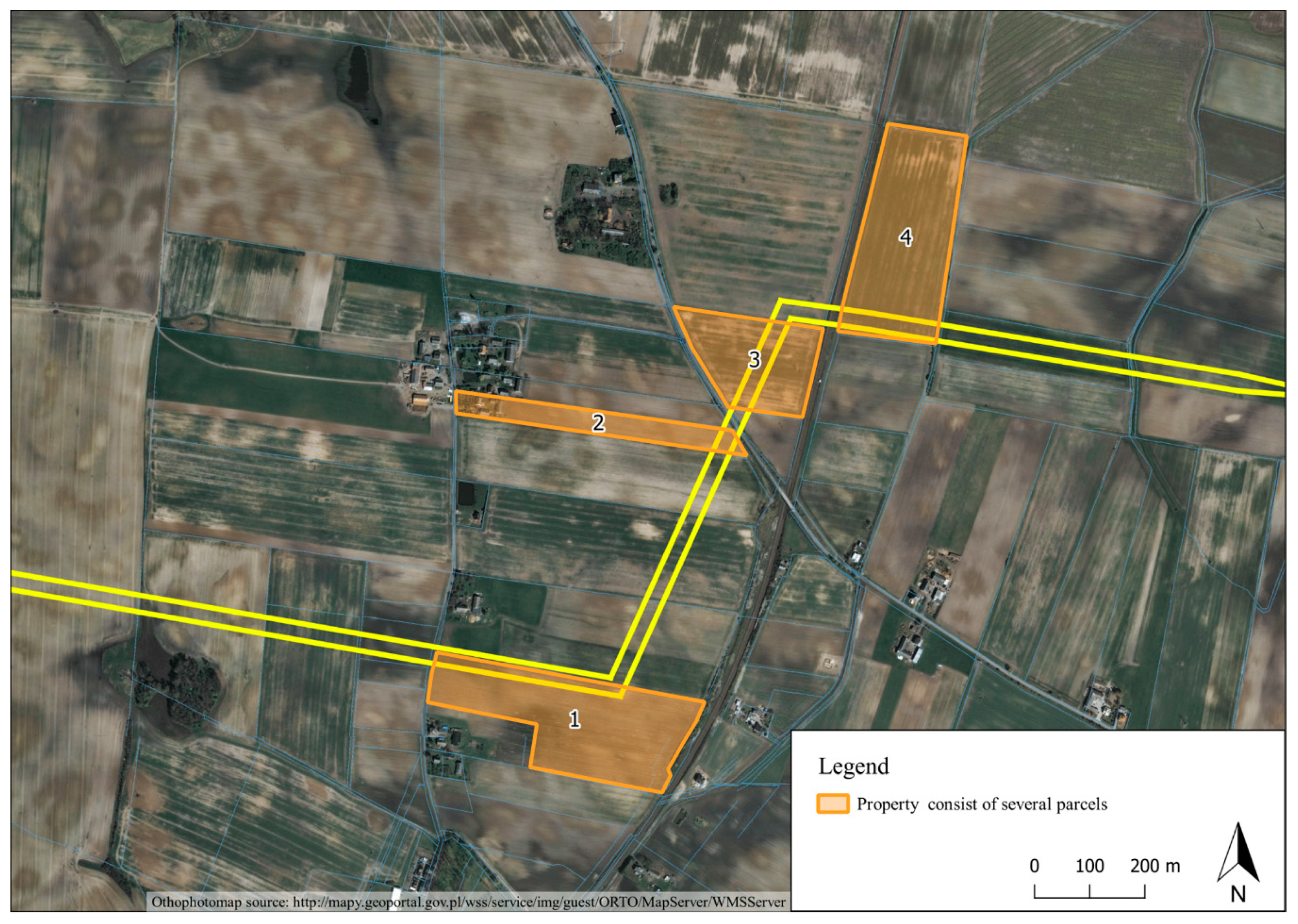
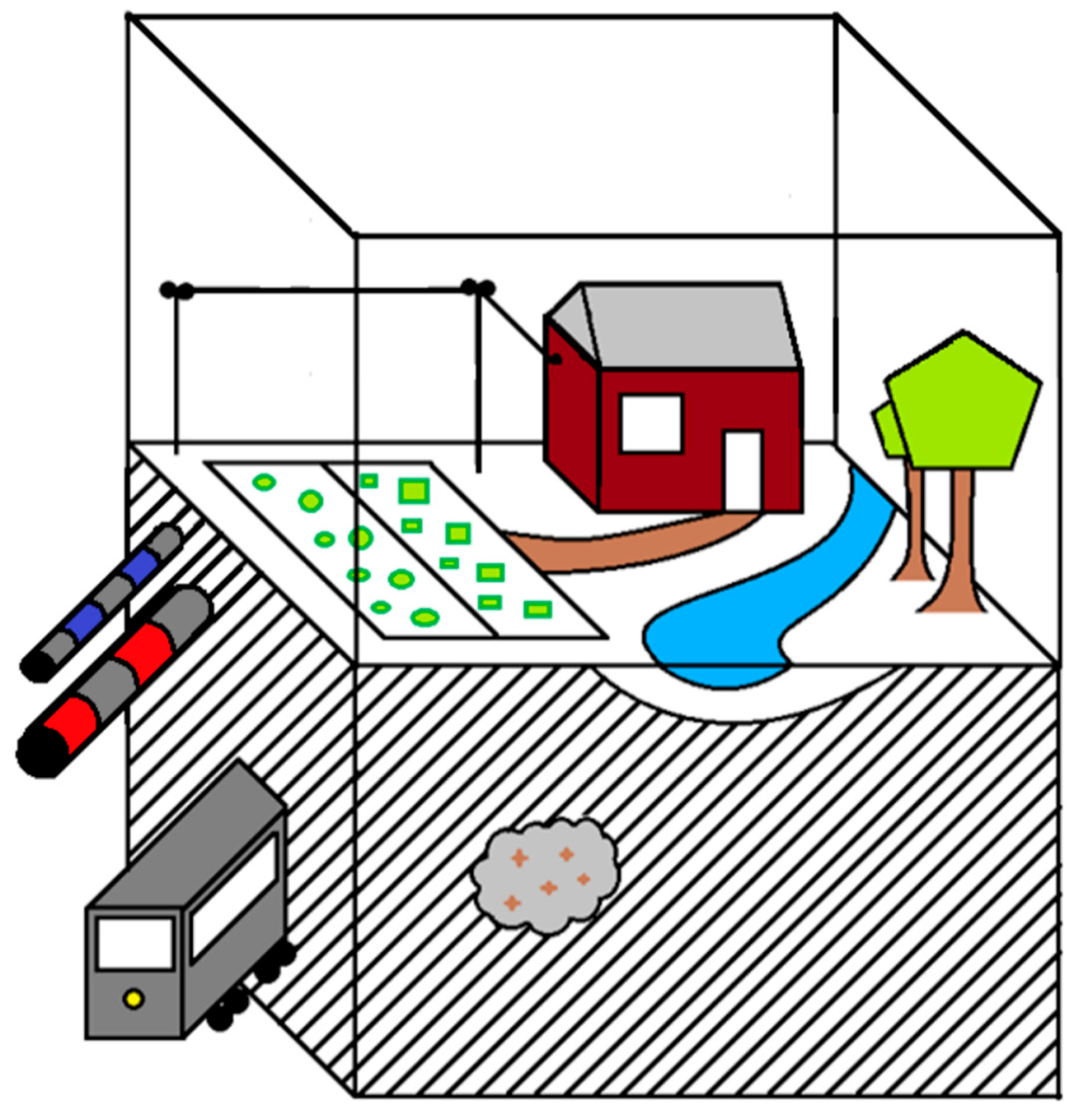
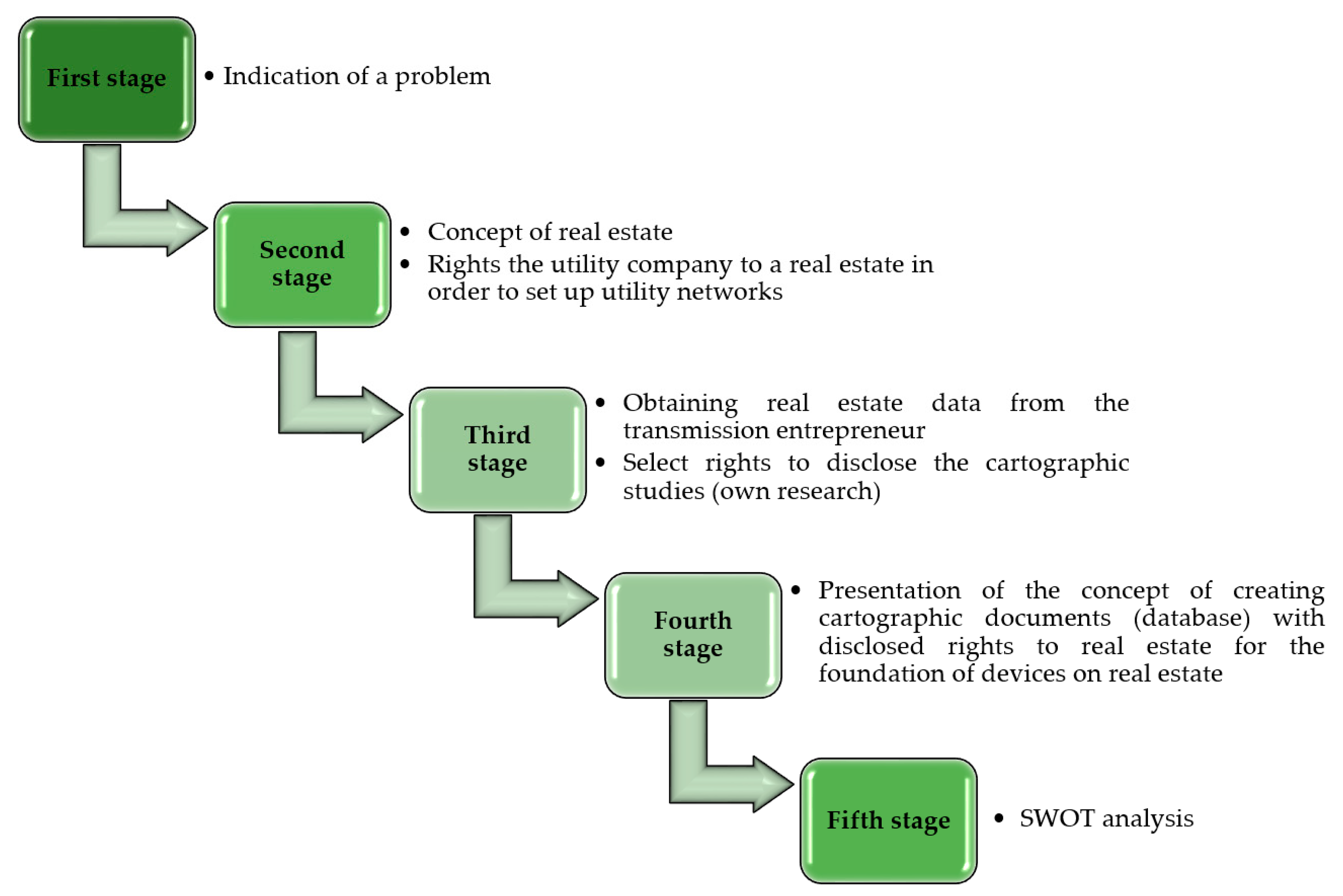
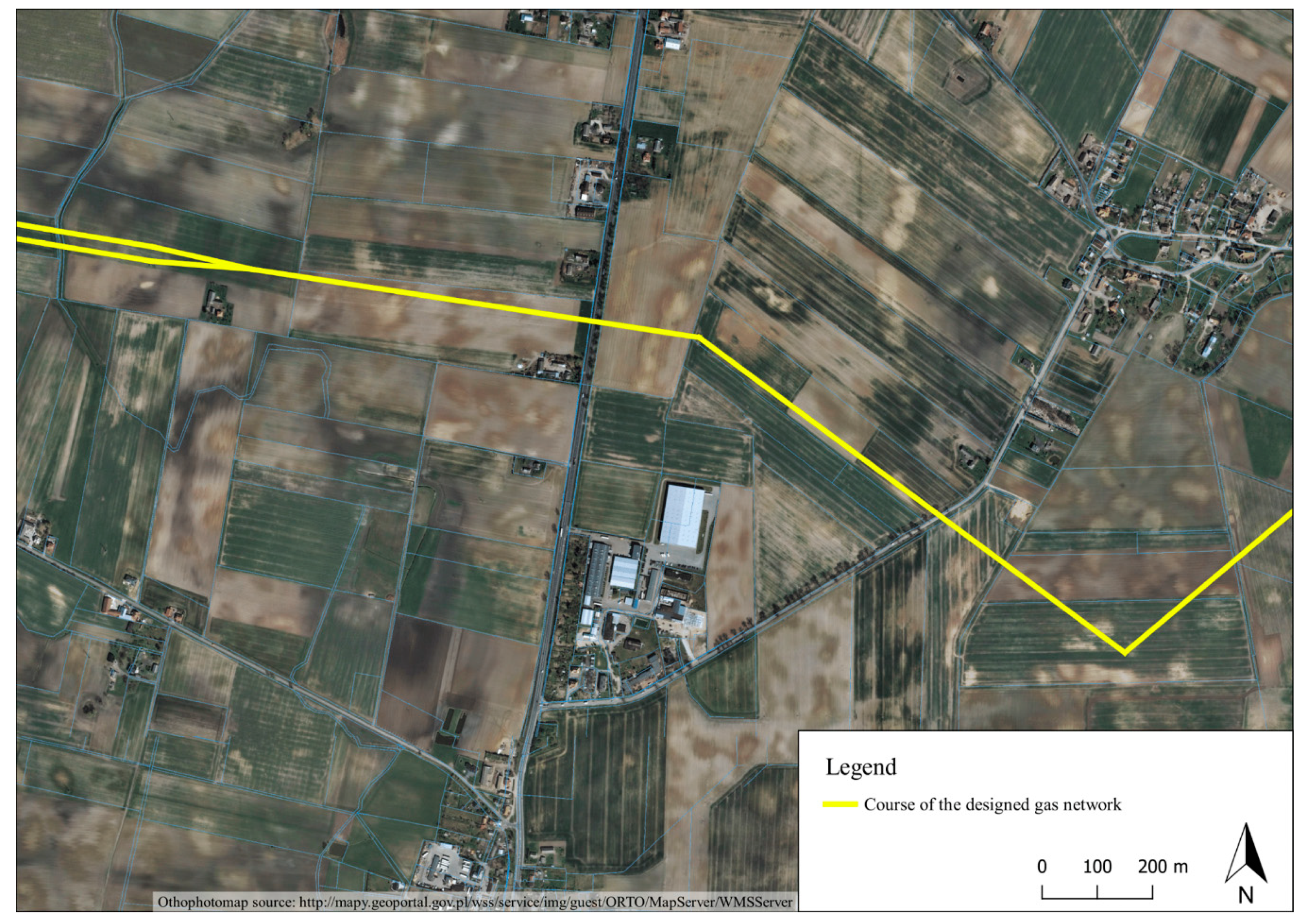
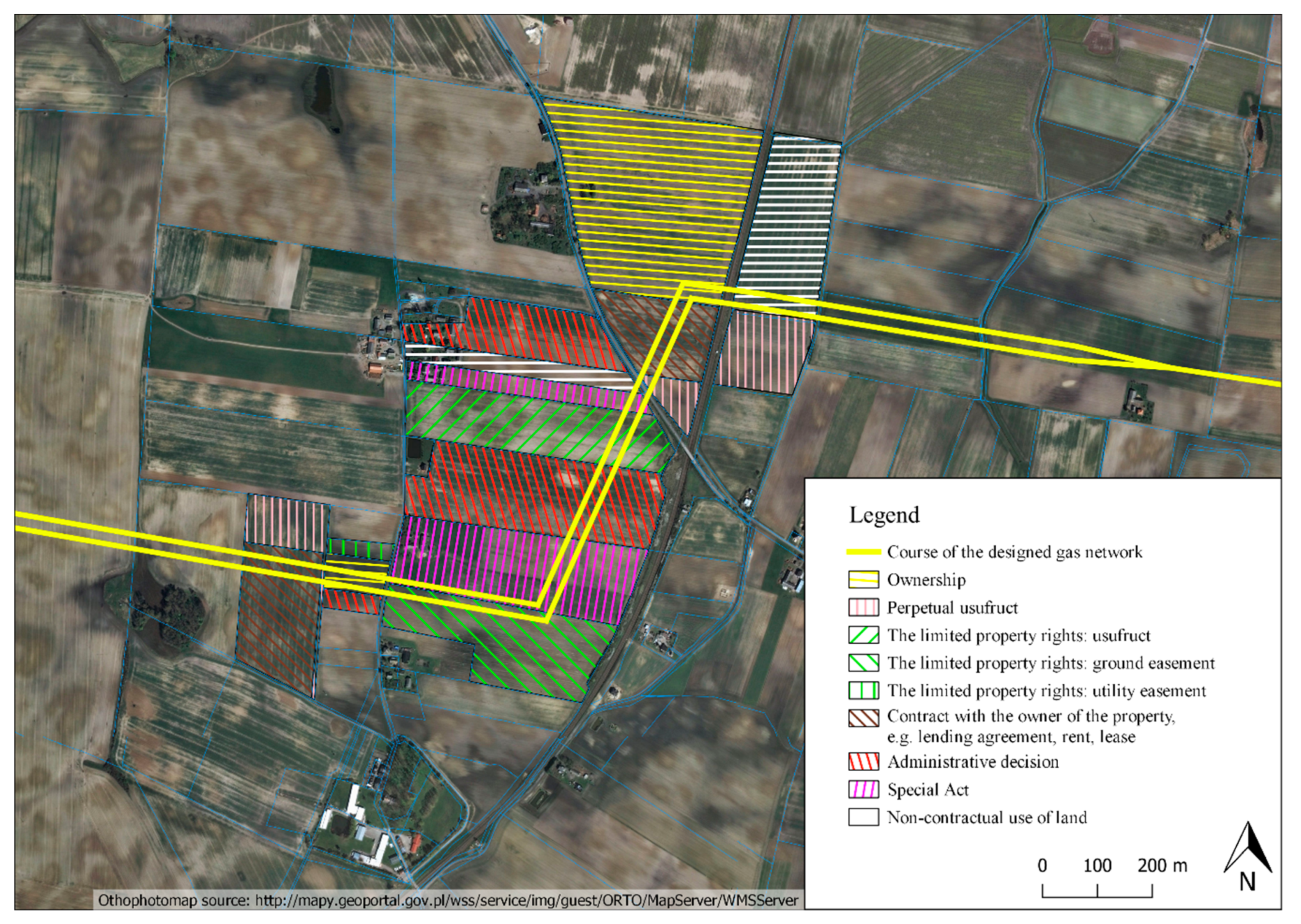
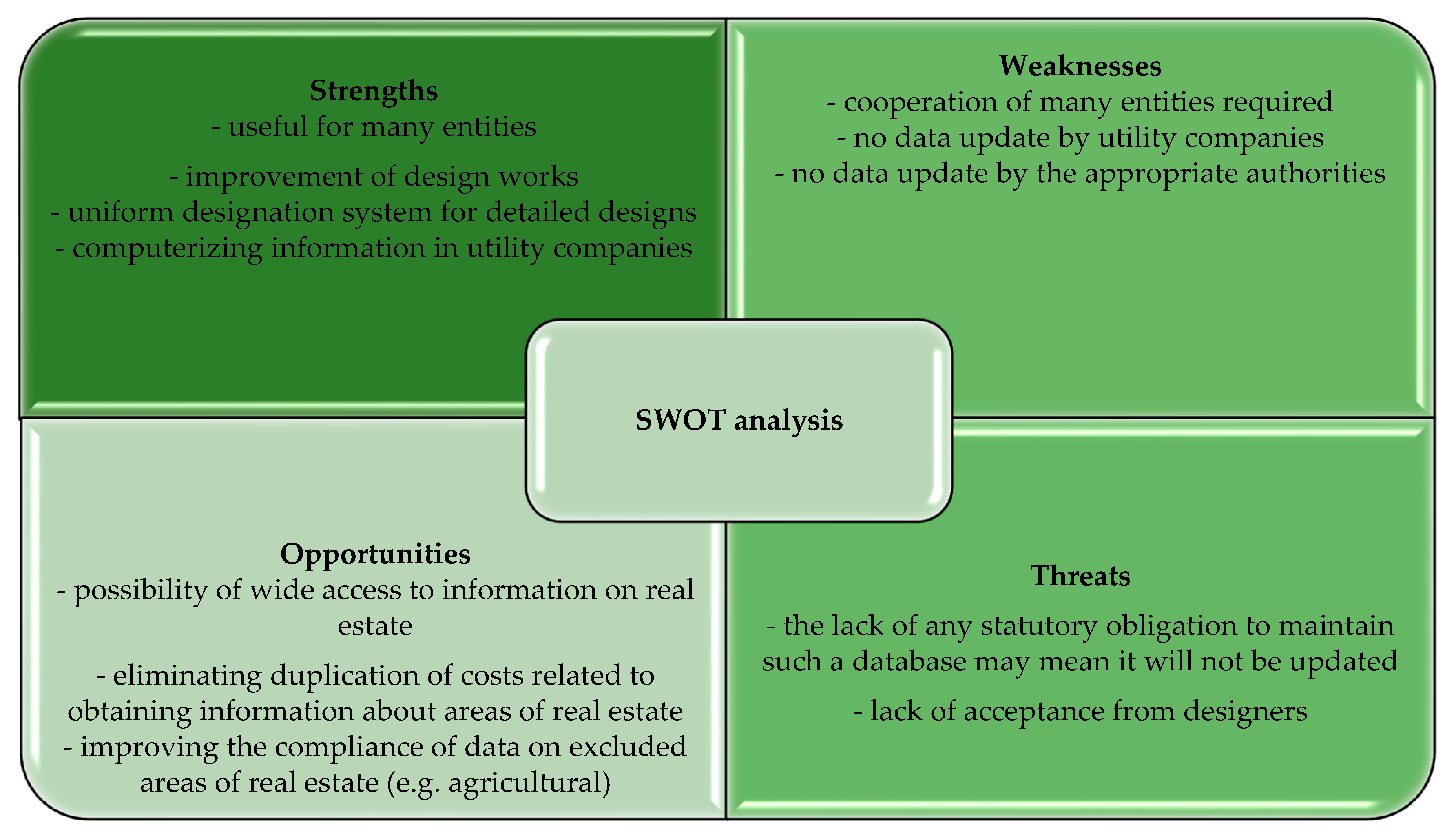
| Right | Permissions/Responsibilities | The Legal Boundaries | Negotiability | The possibility of Obtaining a Building Permit |
|---|---|---|---|---|
| Ownership |
|
| + | + |
| Perpetual usufruct |
|
| + | + |
| Usufruct |
|
| - | + |
| Ground easement |
|
| - | + |
| Utility easement |
|
| + | + |
| Contract with the owner of the property (e.g., lending agreement, rent, lease) |
|
| + | +/- |
| Administrative decision |
|
| +/- | + |
| Special Act |
|
| + | + |
| Network Type | Color | First Letter of the Code | Network Type | Second Letter of Code |
|---|---|---|---|---|
| Gas network | Yellow | G | High pressure (Wysokoprężne) | W |
| Semi-pressure (Średnioprężne) | S | |||
| Low-pressure (Niskoprężne) | N |
© 2019 by the authors. Licensee MDPI, Basel, Switzerland. This article is an open access article distributed under the terms and conditions of the Creative Commons Attribution (CC BY) license (http://creativecommons.org/licenses/by/4.0/).
Share and Cite
Ogryzek, M.; Klimach, A.; Niekurzak, D.; Pietkiewicz, M. Using Cartographic Documents to Provide Geoinformation on the Rights to Real Estate—Taking Poland as an Example. ISPRS Int. J. Geo-Inf. 2019, 8, 530. https://doi.org/10.3390/ijgi8120530
Ogryzek M, Klimach A, Niekurzak D, Pietkiewicz M. Using Cartographic Documents to Provide Geoinformation on the Rights to Real Estate—Taking Poland as an Example. ISPRS International Journal of Geo-Information. 2019; 8(12):530. https://doi.org/10.3390/ijgi8120530
Chicago/Turabian StyleOgryzek, Marek, Anna Klimach, Dominik Niekurzak, and Michał Pietkiewicz. 2019. "Using Cartographic Documents to Provide Geoinformation on the Rights to Real Estate—Taking Poland as an Example" ISPRS International Journal of Geo-Information 8, no. 12: 530. https://doi.org/10.3390/ijgi8120530
APA StyleOgryzek, M., Klimach, A., Niekurzak, D., & Pietkiewicz, M. (2019). Using Cartographic Documents to Provide Geoinformation on the Rights to Real Estate—Taking Poland as an Example. ISPRS International Journal of Geo-Information, 8(12), 530. https://doi.org/10.3390/ijgi8120530






